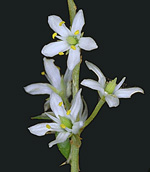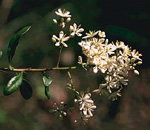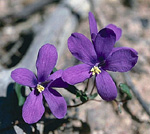 |
This is principally an Australian family, although some genera extend to south-east Asia and Africa. In Australia it is very widespread (being absent only from the western deserts) in many habitat types ranging from rainforests to desert ranges.
Characteristic features of the family Pittosporaceae in Australia include: - shrubs, small trees or (rarely) twining climbers or scramblers, with simple, usually entire, alternate leaves that usually have a strong resinous odour
- flowers bisexual, often showy, yellow, cream, white or blue, with 5 free sepals and 5 petals usually fused at the base
- stamens 5
- ovary often on a short stalk and flattened, usually 1-2-locular, each with 1-several funicled ovules
- fruits are usually more or less dry capsules, sometimes yellow or orange and dehiscing to reveal brightly-coloured, often sticky seeds
Description
Evergreen trees, or shrubs, or subshrubs, or herbaceous vines climbing by twining or scrambling stems, or rarely apparently perennial terrestrial herbs. Perennating by rhizomes. Vegetative reproduction absent or by rhizomes. Stems unarmed, or with thorns or spines arising from the leaf axils; internodes terete or oval or slightly flattened. Internal secretions not obvious or of resin. Plants glabrous, or with simple or dendritic hairs, or rarely (by misinterpretation) stellate, non-glandular, uniseriate hairs. Leaves alternate and spiral, or apparently in whorls of 3–7 or more, petiolate, subsessile or sessile. Stipules absent. Lamina simple, symmetric, filiform, acicular, subulate, linear, lanceolate, ovate, elliptic, oblanceolate or obovate; base cuneate, attenuate, rounded or cordate; margins entire, dentate or sinuate, ±flat, revolute, recurved or undulate; venation pinnate, with the midrib conspicuous, and the tertiary venation not reticulate; surfaces punctate or not punctate; herbaceous or leathery; distinctive odour absent or aromatic. Male and female flowers on separate plants, or with all the flowers bisexual, or with bisexual flowers sometimes occurring together with male flowers on the same plant. Inflorescences terminal or rarely axillary, consisting of racemes, panicles, corymbs, thyrses, umbels, dichasial cymes, or mostly of solitary flowers. Bracts and bracteoles present. Pollination by insects, birds or small mammals. Flowers odourless or fragrant; stalked. Perianth regular, of 2 dissimilar whorls. Calyx segments free or fused, with 5 sepals or lobes, valvate or open or rarely imbricate in bud, herbaceous. Corolla segments free or fused, or some fused and others free, with 5 petals or lobes, alternating with the sepals or calyx lobes, imbricate in bud; corolla wheel-shaped, bell-shaped, urn-shaped or tubular, white, cream, yellow, red, pink, violet or blue, without contrasting markings, or streaked, spotted, etc, membranous; claws present; lobes ±entire. Fertile stamens 5, opposite to the sepals or calyx lobes, free of or fused to the corolla, free of the ovary and style, distinct from each other, grouped or fused into bundles or fused by their anthers, all ±equal or markedly unequal. Anthers dorsifixed, versatile or not versatile, opening inwards by pores, or by short slits or longitudinal slits, 2-celled. Ovary superior and sessile. Carpels 2 (–3), fused; ovary with (1–) 2 (–3) locules. Style terminal, single and unbranched, with the stigma truncate. Ovules 6–16 per locule, stalked; placentation parietal or axile. Fruit dry or fleshy, dehiscent or indehiscent; a septicidal or loculicidal capsule, or 'indehiscent capsule' (carcerulus); the perianth on the maturing fruit deciduous. Disseminule macro-surface featureless or winged; micro-surface ±smooth, ruminate or verrucose, or rarely papillate, orange, red, brown or black, rarely green, glossy. Seeds 6–20 per fruit. Aril rarely present. Cotyledons 2, 3 or more. Embryo round or shapeless.
(Note: this description has been generated from the coded data compiled for the key. Any errors in the key data will be reflected in the descriptions.)
A treatment of the family Pittosporaceae has not yet been published in the Flora of Australia. It will appear in Volume 10.
Australian genera of Pittosporaceae (as recognised for the Flora of Australia)
Bentleya
Billardiera
Bursaria
Cheiranthera
Citriobatus
Hymenosporum
Marianthus
Pittosporum
Pronaya
Rhytidosporum
Sollya

|
  |

Bursaria reevesii (flowers)
Photo: A.Lyne © ANBG

Bursaria spinosa (flowers)
Photo: A.S.George © A.S.George

Cheiranthera preissiana (flowers)
Photo: M.Crisp © ANBG

Hymenosporum flavum (flowers)
Photo: H.Nicholson © H. & N. Nicholson

|

| |